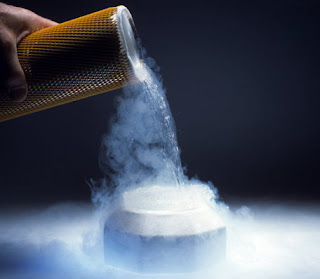Handling cryogenic gases/liquids
pose a very serious safety risk. When
referring to cryogenics we are usually talking about gases that are so
compressed they become liquids and are extremely cold. Cryogenic gases/liquids have boiling points
below -150 degrees Celsius. All
cryogenic liquids are gases at room temperature and normal pressure.
The cylinders the gases are stored in are
under very high pressure, which poses a large risk. Due to pressure contained in the cylinders,
there is an explosion risk and risk of oxygen displacement/asphyxiation if the
gas is suddenly released. These gases
are at such a low temperature they will flash freeze whatever they come in
contact with when released. Cryogenic
liquefied gases are handled in extremely insulated and strong containers. Having such a highly insulated container
reduces the risk of evaporation. Full
body protection is recommended when handling these super cooled materials as
well as pre-planned medical action and services. It is important to use only hardware meant
for cryogenic materials when dealing with them.
Some equipment may seem suitable at first but does not have the
qualifications and can cause an accident.
When an individual is exposed to cryogenic gas the pain is not
immediate. Blood circulation is arrested
fairly quickly. The skin will be
severely “burnt” if not completely frozen and infection may result down the
line. Cell deterioration is a large
threat because many cells exposed to the extreme temperature will die after
thawing. The reason these gases pose
such a high risk of oxygen/air displacement is because of their rate of
expansion. A typical cryogenic liquefied
gas will expand from 1 cubic foot to 875 cubic feet when it is released from
its container. Considering an oxygen
deficient environment only has to be at or below 19% oxygen to be considered
dangerous. Gas expansion can be a huge
risk to human asphyxiation. If a
container is noticed to be leaking, the facility should be evacuated until the
threat is no longer existent. When these cylinders blow up rapidly (oppose to slowly leaking out) they can cause major damage and danger. There are scenarios were these containers have gone through cinder block walls and roofs. This can also trigger a chain reaction. One cylinder can puncture another causing more and more cylinders to explode. Human lives have been lost this way. If the compressed gas is flammable it can cause a whole new threat. If a fire is started the heat surrounding a cylinder can cause the gas/liquid in surrounding cylinders to heat up and expand. This can cause another chain effect, which has obliterated buildings and facilities in the past. This is why it is important to take great care in dealing with highly compressed gases. If tanks are store outside, oxidation of cylinder walls can weaken the tank. Also, employees must handle them will care being sure not to drop or hit tanks. If the gas is flammable, a spark resistant wrench should be used when handling the tank. It is crucial these tanks are equipped with some sort of safety chain when being stored to prevent being tipped over and damaged.



No comments:
Post a Comment